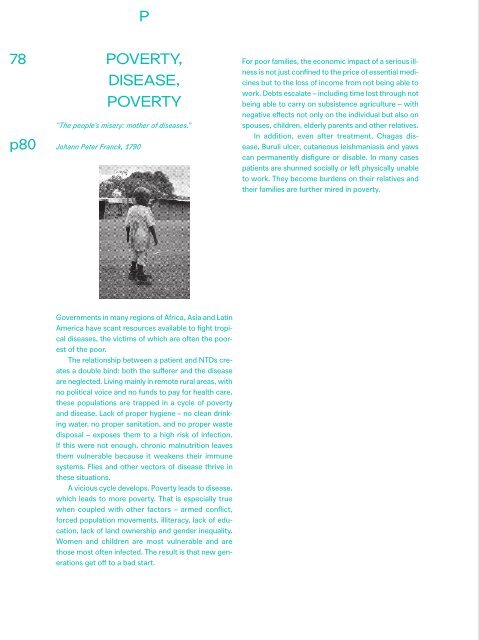You also want an ePaper? Increase the reach of your titles
YUMPU automatically turns print PDFs into web optimized ePapers that Google loves.
P<br />
78<br />
p80<br />
POVERTY,<br />
DISEASE,<br />
POVERTY<br />
“The people’s misery: mother of diseases.”<br />
Johann Peter Franck, 1790<br />
For poor families, the economic impact of a serious illness<br />
is not just confined to the price of essential medicines<br />
but to the loss of income from not being able to<br />
work. Debts escalate – including time lost through not<br />
being able to carry on subsistence agriculture – with<br />
negative effects not only on the individual but also on<br />
spouses, children, elderly parents and other relatives.<br />
In addition, even after treatment, Chagas disease,<br />
Buruli ulcer, cutaneous leishmaniasis and yaws<br />
can permanently disfigure or disable. In many cases<br />
patients are shunned socially or left physically unable<br />
to work. They become burdens on their relatives and<br />
their families are further mired in poverty.<br />
Governments in many regions of Africa, Asia and Latin<br />
America have scant resources available to fight tropical<br />
diseases, the victims of which are often the poorest<br />
of the poor.<br />
The relationship between a patient and NTDs creates<br />
a double bind: both the sufferer and the disease<br />
are neglected. Living mainly in remote rural areas, with<br />
no political voice and no funds to pay for health care,<br />
these populations are trapped in a cycle of poverty<br />
and disease. Lack of proper hygiene – no clean drinking<br />
water, no proper sanitation, and no proper waste<br />
disposal – exposes them to a high risk of infection.<br />
If this were not enough, chronic malnutrition leaves<br />
them vulnerable because it weakens their immune<br />
systems. Flies and other vectors of disease thrive in<br />
these situations.<br />
A vicious cycle develops. Poverty leads to disease,<br />
which leads to more poverty. That is especially true<br />
when coupled with other factors – armed conflict,<br />
forced population movements, illiteracy, lack of education,<br />
lack of land ownership and gender inequality.<br />
Women and children are most vulnerable and are<br />
those most often infected. The result is that new generations<br />
get off to a bad start.


